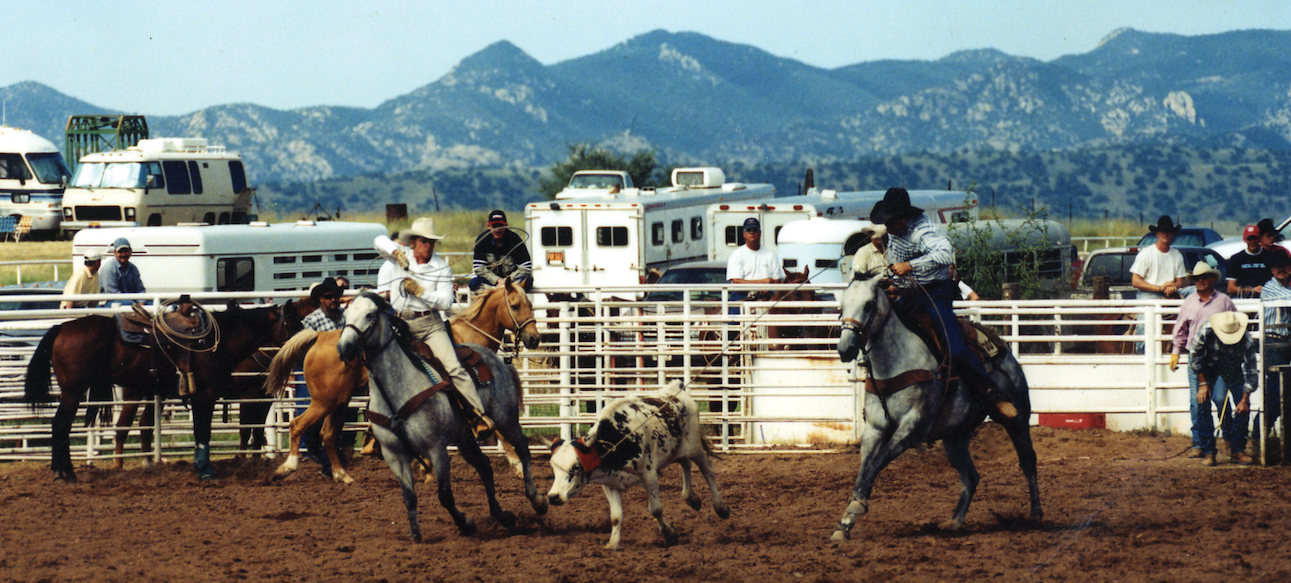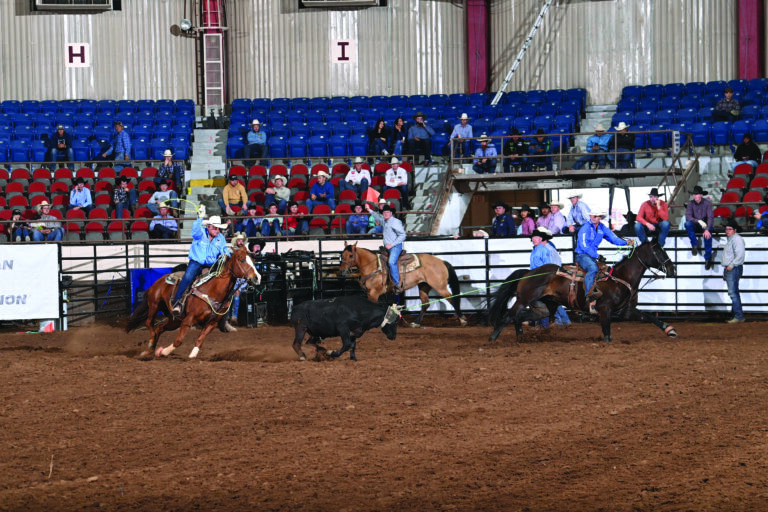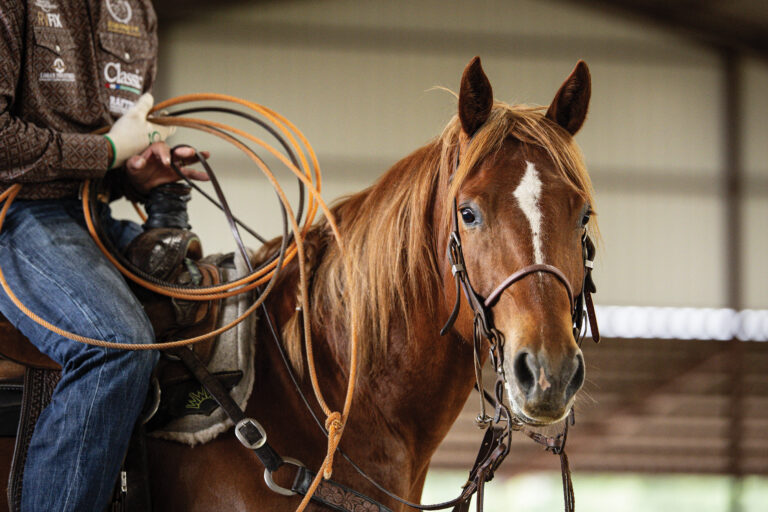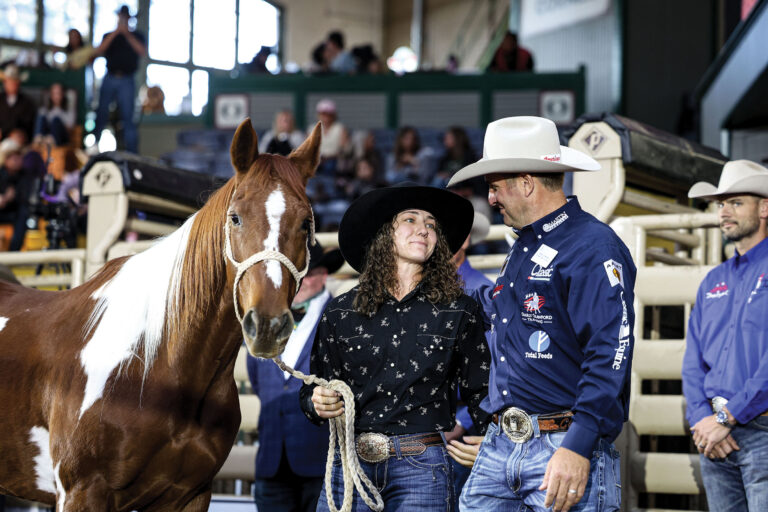
In team roping, “the face” can only happen when the header and the heeler have each done their work. Both having caught, they maneuver at the end of ropes taught with potential energy to turn toward each other—the only way to complete their run. Done well, the face can be a signal of a partnership set for success.
When Fred Fellows and Deborah Copenhaver married, they held between them their lives as professional artists, parents, and the rodeo roots that shaped them. And in the moments—or decades (what is time, really)—since, they’ve crafted works whose elements also face: On one end of the line, an accurate representation of the subject and, on the other, the viewer’s dream of witnessing the art in the moment the artist captured; then, between them, the known and unknown truths that are paramount to authentic and great works.
The Roping Bug
Fred Fellows was born in Ponca City, Oklahoma, in 1934. His family moved to California following the Dust Bowl years, but not before the Osage and prairie cultures—including a familial history with the 101 Ranch—had made their mark. By his teen years, Fred caught the roping bug.
“I started team roping in high school,” said the now 89-year-old. “I worked in a saddle shop for a while—Butler Saddlery in Paramount, California—and then on the weekends, I would go to help Newell Decker. He was a stock contractor, and I would run the steers through the chute. When they were through, when the jackpot was over with or whatever was going on, if there was any steers left, he would work the chute and let me practice roping them.”
California was a great place to be if you wanted to learn how to rope, and Fred was privy to coaching from rodeo cowboys of the time, like RCA All-Around cowboy and National Rodeo Hall of Fame inductee Ross Dollarhide, Jr., who won dozens of championship event titles between 1947 and 1955. Fred also found his first cowboying job on a big-acre ranch in the Mojave Desert.
“I was heading steers for a guy named Tiny Manus, who was the brand inspector for the Los Angeles Stockyards,” Fred said in a podcast interview with Tucson Arizona’s Medicine Man Gallery founder Mark Sublette. “He said, ‘Roping steers in an arena is not the same as punching cows on a ranch. Why don’t you come work for me?’”
It was a line of work that Fred would revisit for years to come, cowboying on storied ranches like southern Montana’s Padlock Ranch, riding out with the wagon and trailing cattle across the Crow Indian Reservation and into the Big Horn Mountains, but his career was driven by his penchant for art, long established since his early days in Ponca City, where a monumental statue, “Pioneer Woman,” rises above the plains and rests firmly in his heart.
READ MORE: Behind the Scenes with Award-Winning Artist and Team Roper Chris Navarro
A Rodeo Family
Deborah Copenhaver was born the daughter of World Champion Saddle Bronc rider and National Cowboy Hall of Fame inductee Deb Copenhaver. In stories, it’s regularly noted that in his rodeo heyday, Copenhaver covered record-setting miles to compete in as many rodeos as possible, whether in Salinas or Madison Square Gardens. At the same time, Deborah and her brother, future World Champion Calf Roper Jeff Copenhaver, were roping cattle in the Northern Idaho branding pens each spring and chasing their own rodeo dreams aboard good horseflesh.
“Jeff won his first roping when he was 11, and I won a barrel racing when I was 12,” Deborah said. “So we were kind of caught by the bug by then. But Dad was always off rodeoing, and he’d bring a made horse home for us. Jeff got a rope horse from a guy in Texas named Buddy Roth; and Bobby Robinson was a bulldogger, and he bought a gelding for me that could run barrels, and a racehorse, too. We always were mounted, and we were always in the arena, and we always had an arena that Dad made.”
When her dad was rodeoing, Deborah’s mother managed the family and its rural, mountain ranch, but when it was time for the kids to go to high school, Spokane, Washington, called.
“My mother was from a very educated family,” Deborah told Medicine Man Gallery’s Sublette in her own “Art Dealer Diaries” podcast episode. “My grandma was one of the first women to graduate college in Wyoming. So, when my brother and I were starting high school, my mother said, ‘We’re moving off the mountain so we can get into a better school district.’”
In high school, the Vietnam War erupted and Deborah enrolled in college as a political science major, but she discovered an art program that catered to her natural talents. After studying sculpture in Italy, she graduated with a degree in fine arts in hand, and she began a commercial interior design firm in Spokane, which led to designing furniture in Seattle. Then, her brother asked her to join him on the rodeo road.
In 1975, the two made a rough go of the winter rodeos until Houston. Broke, Jeff sent Deborah to Arizona, where they would meet after he competed in his final round. Jeff ended up winning the round and, by year’s end, would become the world champ. Deborah ended up discovering Prescott’s Phippen Museum, where she met Western art heavyweights Ernie Phippen, Bill Nebecker and Bill Owen, and she moved to Arizona the next year to apprentice in the foundry.
Crossing Paths
By the time Fred and Deborah met, Fred had married and become the art director of aerospace engineering company Northrop Aircraft Corporation; quit to be a painter in Taos, New Mexico; ran out of money and returned to California’s aerospace industry, only to quit again and move to Idaho, then Montana. He was painting, and he was roping, too.
“Big Fork, Montana, is the north end of Flathead Lake, and it’s right by Flathead Lake Lodge Dude Ranch,” Fred said. “I still wanted to rope, so I helped them build a roping arena and, twice a week, we’d team rope there. Then, when guys would go up north to team rope in the PRCA rodeos, they’d kind of keep their horses there, and I got a chance to really know Leo Camarillo and Reg and Jerold, and different guys that had been to the National Finals. I got a chance to rope with them and it was really fun because I was still an artist and still doing artwork.”
The Cowboy Artists of America organized in 1965 and, in 1969, Fred submitted a member application and work for the annual show in Oklahoma City. Today, the show is held in Fort Worth, and Fred—a three-time president of the CAA—is the longest-standing member of the organization, which aims “to authentically preserve and perpetuate the culture of Western life in fine art.”

In ’75, when Jeff was on his hot streak, he arranged for Deborah to drive him from Spokane to Kalispell for a rodeo … and to make an introduction.
“Jeff said, ‘If you drive with me on an overnight run to Kalispell, I’ll introduce you to Fred Fellows,’” Deborah recalled.
It would be nearly 15 years before Fred and Deborah married in 1990. In between, Deborah became a mother and Fred became a widower. He had developed his art career and was busy with his work, and Deborah was then a full-time sculptor, commissioned to build Vietnam War memorials and monumental tributes to individuals like Bing Crosby and Las Vegas’ Benny Binion, now a familiar fixture in the South Point Hotel and Casino.
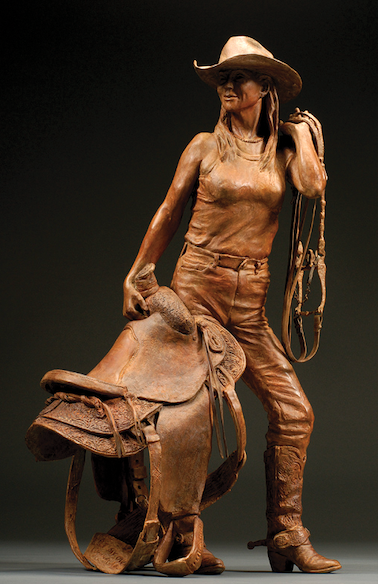
“That all started with Sam McDowell—a pickup man from Montana,” Deborah said. “Sam commissioned me to do a bust of Benny. That’s how I really got acquainted with him. [Benny] had me do his coach: the six-horse hitch that traveled all over. He had me come and measure every one of his horses and do that coach. That’s at the Hall of Champions in Colorado Springs, and the bust I did of him, too.”
The same Hall once housed a series of paintings Fred completed for the National Finals Rodeo in its Hesston days, including a 1987 work titled “Five Flat,” in which a heeler comes tight on a horned, black steer and the header, with steer in tow, looks back intently, awaiting the perfect moment to wheel his horse around and face.
“We went back to the museum a few years ago and the paintings weren’t in the Hall anymore,” Deborah said. “And they couldn’t find them in storage, so we don’t know what happened to them.”
READ MORE: Cowboy Artist Duke Beardsley
From the Studio to the Arena
Lost art aside, Fred and Deborah found in each other an appreciation for each other’s talents in the studio and in the arena, too.
“Once Deborah and I got together, then we really started roping,” Fred said. “We went to a lot of jackpots and serious deals. She took a workshop from Walt Woodard and Mike Beers and different people that we got to know really well. We’ve been team roping all the way through. The last big team roping we went to together was the Rope America Finals that was held in Sonoita.”
Fred and Deborah married right around the time when the USTRC introduced its groundbreaking handicap system, making roping an appealing endeavor for both and was the gateway for them getting to rope on the Hawaiian Islands.
“Bill White had an arena over there and, every year, he put the USTRC finals for the Hawaiian Islands on the Big Island of Hawaii: Kamuela,” Fred recalled of his friend, whose son Ryan owns and operates Best Ever Pads with his wife, the PRCA’s winningest female team roper, Tammy West-White. “He’s been our friend for 50 years, so we went over there and actually roped in the USTRC finals ourselves.”
“I won my first check,” Deborah added. “I think it was ’90 or ’91. I’ve got a picture of me and Bill and that’s my first win check.”

There’s so much that’s wild about roping in Hawaii, including that it’s not at all uncommon to jump-ride a horse for your run.
“There’s cattle ranches and ropers on Lanai, Maui, O’Ahu,” Fred explained. “They can’t carry their horses everywhere, so if you go to another island, they mount you and then they come to your place, you mount them. It’s one of those deals.”
“If you’re lucky, you get a really good one,” Deborah added, speaking fondly of a horse named Ed owned by Freddy Rice. “But the whole point was that you had to be able to get on anything and go rope.”
The challenge speaks to the tenacity of Hawaii’s Paniolos—the local cowboys whose traditions taught them to swim cattle in the ocean to load them on ships and to gather rogue mavericks off the rugged mountains of the islands. To honor the heritage, White and the Paniolo Preservation Society commissioned Fred to build a monument to Ikua Purdy, the born-and-raised Paniolo who became the 1908 Cheyenne Frontier Days Champion Steer Wrestler when he set a 56-second run record on his only trip to Wyoming.
“They’re really proud of Fred’s piece there,” Deborah said of the statue that immortalizes a thrilling downhill chase behind an impressive and motivated bull. “It’s so accurately depicted.”
READ MORE: Island Ranching and Team Roping with Zanga Shutte
Health and Home
Since 2000, the Fellows have made their home and their work on their Sonoita, Arizona, ranch. With the same big-acre-type ranches as their neighbor that Fred cowboyed on throughout his years, the artists, in a way, have become their own subjects.
“We’re at 5,000 feet,” Deborah illustrated. “Grass and oak trees. It looks like Cambria, California. We just go through a gate and there are washes out there and grass, and you can work colts. We used to work colts out there before we’d send them to the track.”
In that way, Deborah has come around to her horses in the same way that Fred has to his big ranches. And for each of them, it’s a way to stay on in the roping industry even if they’re not running down a fast time like they were in days past.
“The truth of the story is that life goes on with us,” Deborah said. “We had to quit something we loved, but I told you earlier that my dad was into racehorses and breeding horses. Good, performance horses. After Fred and I got married, I got a Corona Cartel mare and, the first time I started this program when we moved to Arizona, I bred to a stud named One Famous Eagle, and he’s turned out to be one of the greats.
“I had two colts by One Famous Eagle and they’re both standing over in California,” Deborah continued. “I sold one to Cathy Twisselman and, the other, she and I are partners on, and both of them [were] in the Riata Buckle competition. So, we might not be roping, but we’re breeders in the game now, and I’m really proud of that.”
The Fellows are in great health and Deborah is hard at work on more commissions, including a memorial to the 19 members of Prescott’s Granite Mountain Hotshots who lost their lives battling a wildfire in 2013. The couple’s works are each represented in seven galleries throughout the West, and Fred has turned a keen eye on collecting and researching artifacts of the West—a resource his fellow CAA members have put to good use, often calling him to verify details of their own artworks.
“We’re both blessed,” Deborah said. “Our take on the whole thing is, whatever is said about us when we’re gone, we’ve been blessed.” TRJ
For more artwork by Fred and Deborah Fellows, visit Fellows Studios.




